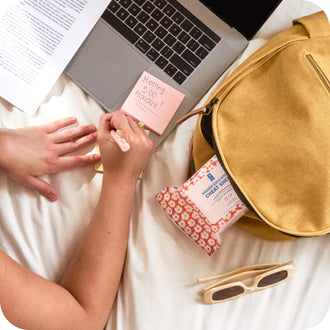
We all can relate to trying all the new skincare "fads" out there to keep our skin smooth and radiant (we'll basically cut off our left arm for good skin). From vampire facials to expensive laser treatments, we strive for clear skin in a bunch of different ways - but amazing skin doesn't take a million dollars or require a weird skincare trend.
As a licensed esthetician, I can relate to your desire for the best and brightest skin. In my experience, the only requirement is EXFOLIATION, ladies; exfoliation is the foundation for healthy, fresh-faced skin, especially when prepping your skin for summer.
Here we go...
CHAPTER I: EXFOLIATION? WHO IS SHE?
Exfoliating the skin is the action of clearing away dead skin cells from the surface of your skin using an exfoliant. There are two different types of exfoliants you can use on the skin: chemical exfoliants or physical exfoliants (I usually recommend both).
There are two methods to physically exfoliate the skin: using a skin exfoliating device such as a scrubbing brush OR you can use a gentle scrub with environmentally friendly granules like microbeads. Regardless of your preferred method, I recommend physically exfoliating 3-5 times a week depending on your skin type.
Chemical exfoliators with alpha hydroxy acids (AHAs), beta hydroxy acids (BHAs) or enzymes can be applied daily to the surface of the skin to loosen the bond-like substance that holds dead skin cells together.
Summary: physical and chemical exfoliation are the two methods of exfoliation. It is recommended to physically exfoliate 3-5x per week and you can chemically exfoliate the skin daily.
CHAPTER II: WHY DO I NEED TO EXFOLIATE?
Your skin is constantly renewing itself; this is known as the natural life cycle of the skin. New cells are formed in the epidermis and gradually move up through the skin until they reach the outer layer where they die. These cells are called 'keratinocytes' and are composed of the fibrous protein keratin. When dead cells accumulate on the surface of the skin, it can make your appearance dull, flaky or even dry. If these dead cells collect in your pores it can lead to blackheads, whiteheads and pimples. Even worse, if bacteria fester, you may get acne pustules.
Daily exfoliation helps purge your skin of these residual dead cells revealing smoother, more luminous skin and helps diminish the occurrence of clogged pores. If your skin is riddled with dead cells, your skincare products may not be able to penetrate the skin and do their work. By removing the dead cells on the outermost layer of the epidermis, (also known as the stratum corneum), you clear away these clog poring keratinocytes and prep your skin for better product penetration.
Acne prone skin needs exfoliation as well, to help break the bond of dead skin cells. Additionally, exfoliation helps fade and reduce post inflammatory hyperpigmentation (PIH) by encouraging your cell turnover rate and stimulating collagen production - yay collagen! Daily exfoliation is recommended, and if you exfoliate religiously, you'll start to see results.
Summary: the cells that compose the outer layer of your skin are called keratinocytes and if not properly exfoliated, can clog your pores and lead to acne. Regular exfoliation leads to bright, vibrant skin.
CHAPTER III: HOW TO EXFOLIATE
Step 1: When using a physical exfoliant, start by cleansing your face with HIGHER EDUCATION PRE-REQ® Purifying Facial Cleanser. It's specifically formulated for oily to combination skin.
Step 2: After cleansing with Pre-Req™, take a quarter-size amount HIGHER EDUCATION GRINDING AWAY® Skin Polishing Scrub and apply it to your face in circular motions, avoiding the eye area. Lightly massage the product onto the skin, anywhere from 30 seconds to a full minute. Then rinse off with lukewarm water and gently pat your skin with a damp towel.

*When using a chemical (liquid) exfoliant, wash your face with a cleanser and pat it dry. If your chemical exfoliant comes in a convenient pre-moistened pad, like HIGHER EDUCATION EASY A® Glycolic Acid Exfoliating Pads and RUSH® Salicylic Acid Complexion Pads, apply the pad all over your entire face, neck, décolleté, avoiding the eye area. Allow time for the chemical exfoliant to be completely absorbed into the skin before moving on to the next step in your regimen.
Step 3: Follow with your serum, hydrator and sunscreen. I recommend HIGHER EDUCATION SPRING BREAK® Oil-Free Sunscreen SPF 30 for your daily sun protection.
Other types of chemical exfoliants, often called "peels", can be applied to the skin similarly to facial masks, left on for 10-15 minutes and then rinsed off (always check your product label and instructions to make sure you're using it correctly). Exfoliating too often or too rigorously may cause irritation on the skin's surface and strip your skin's natural moisture barrier. If you have acne, rosacea or sensitive skin, ask your dermatologist or esthetician to determine what exfoliants to use and how often to use it!
Summary: Exfoliation should be the second step in your skincare routine. For maximum efficacy, manually exfoliate the skin for 30 seconds to a minute.
CHAPTER IV: AHA? BHA? BAHAHA I DON'T UNDERSTAND THEM
Let's start with decoding AHA's: an AHA is an alpha-hydroxy acid; sounds bad a** because they are. AHA's are derived from a natural plant source and are water soluble (which is fantastic). Simply put, AHA's are dead-skin detonators.
Let me paint a picture: the outer layer of your skin is like a cement wall and AHA's work by dissolving or unchaining the cement in between your cells, allowing them to loosen and detach easier, exposing a brighter, healthier wall beneath.
Some common AHA's used in skin care products are lactic acid, citric acid and glycolic acid. These ingredients are great for all skin types. Try HIGHER EDUCATION EASY A® Glycolic Acid Exfoliating Pads with glycolic acid for that *I didn't go on vacation, but I look like I did* glow.
Beta-hydroxy acids or BHA's on the other hand are oil soluble, which means they are extremely effective for oily and acne prone skin. BHA's penetrate the pores for an extra-deep clean.
The best known BHA is salicylic acid, a proven ingredient in fighting breakouts and acne. RUSH® Salicylic Acid Complexion Pads and added hydrators help rush away dead skin cells and excess oil without stripping the skin of essential moisture.
Remember, not all AHA and BHA liquid exfoliators are made to serve the same purpose, so reading the labels on the box is an essential step to selecting products that work best for your skin type. In fact, products with too much acidity upsets the natural pH balance of the skin and can lead to unwanted hyperpigmentation. For more information on skin pH, read our blog on pH.

Summary: Common AHA's are lactic acid, citric acid and glycolic acid and they are great for all skin types. The most common BHA is salicylic acid, which is especially good for oily, acne-prone skin.
CHAPTER V: AHA & BHA Q & A
WHAT ARE THE BENEFITS OF USING AHA/BHA'S?
Have you ever thought about why every darn skincare brand seems to be jumping on AHA/BHA train? Well when they're used properly, products with these powerful ingredients have several complexion improving benefits. They improve the look of uneven texture, increase cell turnover, unclog pores, minimize post inflammatory hyperpigmentation (PIH) and act as a skin booster to allow superior absorption of your favorite serums and hydrators.
IS IT POSSIBLE TO USE BOTH AHAS AND BHAS?
Yes! They have separate benefits but can also work simultaneously. AHAs will slough away dead skin cells, while BHAs will cleanse your pores and fight bacteria.
WHICH INGREDIENTS SHOULD I BE ON THE LOOK-OUT FOR?
Salicylic acid →an anti-inflammatory, anti-bacterial BHA derived from aspirin (don't use if you have an allergy).
Glycolic acid →a classic exfoliant that gets the job done, is the smallest alpha-hydroxy and a great year-round exfoliant.
Lactic acid →My go-to AHA because it's a larger molecule than glycolic acid, which means that while it might take a bit little longer to penetrate, the skin has an adjustment period that is needed with the acidic pH. Lactic acid also hydrates and that is why it's extremely effective for dry sensitive skin types.
CHAPTER VI: HOW-TO INTRODUCE EXFOLIANTS INTO YOUR DAILY SKINCARE ROUTINE
I recommend you start by selecting a product with lactic acid; this is hydrating acid and is found in the luxe HIGHER EDUCATION GRINDING AWAY® Skin Polishing Scrub and the refreshing RUSH® Salicylic Acid Complexion Pads. To start, go for a lower concentration and remember experiencing light tingling is normal.
If you experience itching and burning, try using a product with less acid concentration or use them less often. Your skin will begin to build up a tolerance and you can work your way to stronger skin. To be safe, try a patch test for any acid-based products on your neck to be sure you won't experience unnecessary irritation.
Introduce your liquid exfoliating pads after cleansing in the morning and evening. Just remember, using a daily SPF is even more crucial when you're using an acid-based exfoliator. While these AHA's and BHA's can help fade hyperpigmentation brought on by UV exposure, both AHA's and BHA's can also increase skin's sensitivity to the sun's rays.
Summary: Start slow with exfoliants and try a patch test if you are nervous. Light tingling is normal, but burning is not.
HOW OFTEN SHOULD I EXFOLIATE?
Once your skin is used to acid-based products, a physical exfoliant is perfect to use 2 to 3 times a week, although it all depends on the strength of the formula and your specific skin type. Chemical exfoliants are best for daily use and when you’re feeling extra fancy, you can use an exfoliating face mask like STUDY BUDDY® Detoxifying Bentonite Clay Mask one or two times a week. It contains lactic and glycolic acid to dissolve dead skin cells, bentonite clay to absorb excess oil and vitamin C to brighten the complexion.
EPILOGUE:
Exfoliation is a very important step in any skincare routine. At Higher Education Skincare we recommend 3 essential steps to youthful skin: Cleanse, exfoliate, and hydrate. 3 simple steps that don't break the bank, so you can crush your life and your skincare routine. No stress, no bs.

























